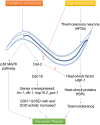Caenorhabditis elegans, a Host to Investigate the Probiotic Properties of Beneficial Microorganisms
- PMID: 33425969
- PMCID: PMC7786404
- DOI: 10.3389/fnut.2020.00135
Caenorhabditis elegans, a Host to Investigate the Probiotic Properties of Beneficial Microorganisms
Abstract
Caenorhabditis elegans, a non-parasitic nematode emerges as a relevant and powerful candidate as an in vivo model for microorganisms-microorganisms and microorganisms-host interactions studies. Experiments have demonstrated the probiotic potential of bacteria since they can provide to the worm a longer lifespan, an increased resistance to pathogens and to oxidative or heat stresses. Probiotics are used to prevent or treat microbiota dysbiosis and associated pathologies but the molecular mechanisms underlying their capacities are still unknown. Beyond safety and healthy aspects of probiotics, C. elegans represents a powerful way to design large-scale studies to explore transkingdom interactions and to solve questioning about the molecular aspect of these interactions. Future challenges and opportunities would be to validate C. elegans as an in vivo tool for high-throughput screening of microorganisms for their potential probiotic use on human health and to enlarge the panels of microorganisms studied as well as the human diseases investigated.
Keywords: Caenorhabditis elegans; immunity; lifespan; pathogens; probiotics; stress response.
Copyright © 2020 Poupet, Chassard, Nivoliez and Bornes.
Figures




References
-
- FAO/WHO Evaluation of health and nutritional properties of probiotics in food including powder milk with live acid bacteria. Report of a Joint FAO/WHO Expert Consultation, Córdoba, Argentina (2001). Available online at: http://www.who.int/foodsafety/publications/fs_management/en/probiotics.p...
-
- Desreumaux P, Pavan S, Mercenier A. Probiotiques, prébiotiques et symbiotiques. La Lett Hépato Gastroentérol. (2000) 3:335–7.
Publication types
LinkOut - more resources
Full Text Sources
Other Literature Sources

